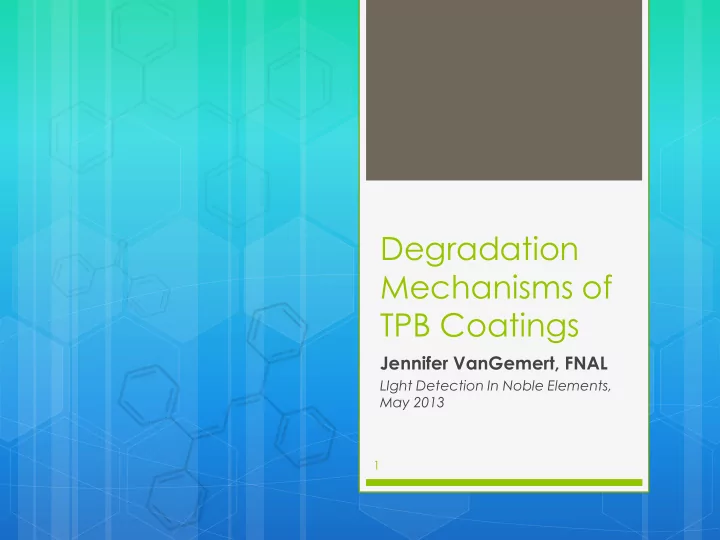

Degradation Mechanisms of TPB Coatings Jennifer VanGemert, FNAL LIght Detection In Noble Elements, May 2013 1
2 Tetraphenyl Butadiene High absorption coefficient at 128nm Emission spectrum maximum near 450nm Emits 1.3 photons for each incident photon Fragile pure coating strengthened with toluene/polystyrene mixture
3 Coating Styles Coatings brush coated onto plates, TPB embedded in polystyrene for mechanical robustness “Rough” Coating Designed for maximum WLS efficiency (TPB crystalizes on surface) Used in MicroBooNE PMT assembly 3 coats of 50% TPB and 50% PS in toluene solution “Smooth” Coating Designed for smooth optical surface for light guiding Used in paddle / lightguide detectors 1 coat of 25% TPB in PS in Toluene solution
4
5
6
7 This Talk:
8 GCMS Studies Gas chromatography to separate compounds of different mobility, followed by mass spectrometry Impurities are visible to the GCMS at ppm levels.
9 GCMS GC vaporizes sample Compounds in sample separate as they pass through chromatographic column MS ionizes compounds Sample mass spectrum compared to known spectra
10 WHITE TPB Plot shows diffusion speed through the GC column Each bin then has a mass spec taken.
11 TPB Mass Spec, NIST TPB Mass Spec, measured
12 Remember this?
13
14 Benzophenone Wikipedia says:
15 Controlled Study: Produce ~30 TPB coated plates Measure WLS performance of each before degradation Degrade under a UV lamp (300nm) After some exposure time, measure WLS performance again Dissolve off coating with toluene bath with sonicator Quantify benzophenone relative to TPB Fresh solvent run between each sample to minimize cross contamination
16
17
18 So where is the yellow? BP is white, not yellow However, many of its simple derivatives are yellow Possibly a second stage after BP production, to produce yellow BP derivatives?
19 Impact of Added BP on Yellowing TPB + benzophenone TPB only This observation supports the interpretation on the previous slide…
20 Log scale here – initial ~exponential rise suggests radical mediated reaction
21 Hypothesis Photo-initiated radical mediated reaction turns TPB into benzophenone Second stage reaction turns benzophenone into various derivatives.
22 Terminating Radical Reactions Compounds exist which are used to terminate these reactions Stopping the reaction prevents further degradation BHT We tried two common radical eaters: Butylhydroxytoluene (BHT) 4-tert Butylcatechol (BC) If they slow down this reaction, BC confirmation that we see a radical mediated photo-oxidation.
23
24 20% BC No BC
25 Conclusions We have identified an impurity, benzophenone, which is a known UV blocker and photo-initiator, which builds up with UV exposure in TPB Rate of buildup indicates radical mediated photo-oxidation, this was confirmed by stabilizer tests We can improve coatings by 20% and significantly stabilize them with 4-tert butylcatechol. Yellow also connected to BP, likely production of derivatives in a second stage reaction. Investigations of other radical removing stabilizers are ongoing – maybe we can find an even better one!
26 BACKUP SLIDES
27 Contact Information If you have further questions not answered in this talk or workshop, feel free to contact me at: jennifer.thompson618@gmail.com
28 Compare NMR benzophenone
29 20% BC No BC
30 Yellowing in DHCL3 Solution White Standard YellowStandard Scint
Recommend
More recommend